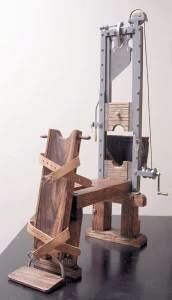In this article we will tell you facts about the Guillotine. The equipment is famous for its use in France, especially during the French Revolution, when it “became a part of popular culture”. The Guillotine is a set of equipment made for carrying out executions by cutting off someone’s head. It consists of a tall upright frame in which a weighted and angled blade is raised to the top and suspended. Let’s explore more interesting facts about the Guillotine through the list below.
Facts about the Guillotine 1: The Halifax Gibbet
Before 1792, there were other beheading machines existed. It was named the Halifax Gibbet which designed from wooden and axe. This wooden structure of two wooden uprights, capped by a horizontal beam, has a total height of 4.5 meters. The blade was an axe head weighing 3.5 kg, attached to the bottom of a massive wooden block that slid up and down in grooves in the uprights.
Facts about the Guillotine 2: The Penalty Tools
Before the use of the Guillotine, there are several tools used for the death penalty. The devices are sword, axe, the breaking wheel and fire. Find out facts about the Dugong here
Facts about the Guillotine 3: Inventor
The actual inventor of the prototype was Antoine Louis. He and German engineer named Tobias Schmidt built a prototype for the guillotine. Schmidt recommended using an angled blade as opposed to a round one.
Facts about the Guillotine 4: Joseph-Ignace Guillotin
Despite the fact that he did not invent the guillotine and opposed the death penalty, his name became an eponym for it. He was a French physician who proposed on 10 October 1789 the use of a device to carry out death penalties in France, as a less painful method of execution.
Facts about the Guillotine 5: The First Execution
Nicolas Jacques Pelletier became the first man executed by guillotine. He was executed on 25 April 1792 in front of area which is now the city hall of Paris.
Facts about the Guillotine 6: The Reign of Terror
It was a period of violence that occurred from 5 September 1793 to 28 July 1794 after the onset of the French Revolution, incited by conflict between rival political factions, the Girodins and the Jacobins, and marked by mass executions of “enemies of the revolution”.
Facts about the Guillotine 7: The National Razor
The National Razor was famous term for the guillotine during the French Revolution. It became the symbol of the revolutionary cause, strengthened by a string of executions: King Louis XVI, Marie Antoinette, the Girondins, Philippe Égalité (Louis Philippe II, Duke of Orléans), and Madame Roland, and others such as pioneering chemist Antoine Lavoisier, lost their lives under its blade. Find out facts about the First Moon Landing here
Facts about the Guillotine 8: Popular Entertainment
At that time, executions by guillotine were a popular entertainment that attracted great crowds of spectators. Vendors sold programs listing the names of those scheduled to die. Many people came day after day and vied for the best locations from which to observe the proceedings.
Facts about the Guillotine 9: The Last Person Guillotined in France
On 10 September 1977, Hamida Djandoubi became the last person guillotined in France.
Facts about the Guillotine 10: Guillotines in German
Nazi records indicate that between 1933 and 1945, 16,500 people were executed by guillotine in Germany and Austria. It was used for the last time in West Germany in 1949 (in the execution of Richard Schuh) and in East Germany in 1966 (in the execution of Horst Fischer).
We want to know your opinion related to facts about the Guillotine, so leave us comment and keep reading.










 www.PortlandPayday.Loans
www.PortlandPayday.Loans